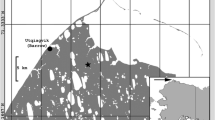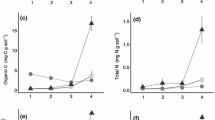Abstract
Large migratory grazers commonly influence soil processes in tundra ecosystems. However, the extent to which grazing effects are limited to intensive grazing periods associated with migration has not previously been investigated. We analyzed seasonal patterns in soil nitrogen (N), microbial respiration and extracellular enzyme activities (EEAs) in a lightly grazed tundra and a heavily grazed tundra that has been subjected to intensive grazing during reindeer (Rangifer tarandus L.) migration for the past 50 years. We hypothesized that due to the fertilizing effect of the reindeer, microbial respiration and EEAs related to microbial C acquisition should be higher in heavily grazed areas compared to lightly grazed areas and that the effects of grazing should be strongest during reindeer migration. Reindeer migration caused a dramatic peak in soil N availability, but in contrast to our predictions, the effect of grazing was more or less constant over the growing season and the seasonal patterns of microbial activities and microbial N were strikingly uniform between the lightly and heavily grazed areas. Microbial respiration and the EEAs of β-glucosidase, acid-phosphatase, and leucine-aminopeptidase were higher, whereas that of N-acetylglucosamidase was lower in the heavily grazed area. Experimental fertilization had no effect on EEAs related to C acquisition at either level of grazing intensity. Our findings suggest that soil microbial activities were independent of grazing-induced temporal variation in soil N availability. Instead, the effect of grazing on soil microbial activities appeared to be mediated by substrate availability for soil microorganisms. Following a shift in the dominant vegetation in response to grazing from dwarf shrubs to graminoids, the effect of grazing on soil processes is no longer sensitive to temporal grazing patterns; rather, grazers exert a consistent positive effect on the soil microbial potential for soil C decomposition.



Similar content being viewed by others
References
Allison SD, Gartner TB, Holland K, Weintraub MN, Sinsabaugh RL. 2007. Soil enzymes: linking proteomics and ecological processes. In: Hurst CJ, Garland JL, Mills AL, Eds. Manual of environmental microbiology. 3rd edn. Washington, DC: ASM Press. p 704–11.
Allison SD, Weintraub MN, Gartner TB, Waldrop MP. 2011. Evolutionary-economic principles as regulators of soil enzyme production and ecosystem function. In: Shukla G, Varma A, Eds. Soil enzymology, soil biology, Vol. 22. Berlin: Springer. p 229–43.
Boerner REJ, Decker KLM, Sutherland E. 2000. Prescribed burning effects on soil enzyme activity in a southern Ohio hardwood forest: a landscape-scale analysis. Soil Biol Biochem 32:899–908.
Brookes PC, Kragt JF, Powlson DS, Jenkinson DS. 1985. Chloroform fumigation and the release of soil nitrogen: the effects of fumigation time and temperature. Soil Biol Biochem 17:831–5.
Buckeridge KM, Grogan P. 2008. Deepened snow alters soil microbial nutrient limitations in arctic birch hummock tundra. Appl Soil Ecol 39:210–22.
Chapin FSIII, Johnson DA, McKendrick JD. 1986. Seasonal movement of nutrients in plants of differing growth form in an Alaskan tundra ecosystem: implications for herbivory. J Ecol 68:189–209.
De Deyn GB, Cornelissen JHC, Bardgett RD. 2008. Plant functional traits and soil carbon sequestration in contrasting biomes. Ecol Lett 11:516–31.
Eskelinen A, Oksanen J. 2006. Changes in the abundance, composition and species richness of mountain vegetation in relation to summer grazing by reindeer. J Veg Sci 17:245–54.
German DP, Weintraub MN, Grandy AS, Lauber CL, Rinkes ZL, Allison SD. 2011. Optimization of hydrolytic and oxidative enzyme methods for ecosystem studies. Soil Biol Biochem 43:1387–97.
Gornall JL, Woodin SJ, Jónsdóttir IS, Van der Wal R. 2009. Herbivore impacts to the moss layer determine tundra ecosystem response to grazing and warming. Oecologia 161:747–58.
Grellmann D. 2002. Plant responses to fertilization and exclusion of grazers on an arctic tundra heath. Oikos 98:190–204.
Hernandez DL, Hobbie SE. 2010. The effects of substrate composition, quantity, and diversity on microbial activity. Plant Soil 335:397–411.
Hodge A, Robinson D, Fitter A. 2000. Are microorganisms more effective than plants at competing for nitrogen? Trends Plant Sci 5:304–8.
Jonasson S, Chapin FSIII, Shaver GR. 2001. Biogeochemistry in the Arctic: patterns, processes and controls. Global biogeochemical cycles in the climate system. San Diego, CA: Academic Press. p 139–50.
Jonasson S, Michelsen A, Schmidt IK, Nielsen EV. 1999. Responses of microbes and plants to changed temperature, nutrient, and light regimes in the arctic. Ecology 80:1828–43.
Kielak AM, Cretoiu MA, Semenov AA, Sorensen SJ, van Elsas JD. 2013. Bacterial chitinolytic communities respond to chitin and pH alteration in soil. Appl Environ Microbiol 79:263–72.
Mack MC, Schuur EAG, Bret-Harte MS, Shaver GR, Chapin FSIII. 2004. Ecosystem carbon storage in arctic tundra reduced by long-term nutrient fertilization. Nature 431:440–3.
McKendrick JD, Batzli GO, Everett KR, Swanson JC. 1980. Some effects of mammalian herbivores and fertilization on tundra soils and vegetation. Arctic 12(4):565–78.
Oksanen L, Virtanen R. 1995. Topographic, altitudinal and regional patterns in continental and suboceanic heath vegetation of northern Fennoscandia. Acta Bot Fennica 153:1–80.
Olofsson J, Kitti H, Rautiainen P, Stark S, Oksanen L. 2001. Effects of summer grazing by reindeer on composition of vegetation, productivity and nitrogen cycling. Ecography 24:13–24.
Olofsson J, Stark S, Oksanen L. 2004. Reindeer influence on ecosystem processes in the tundra. Oikos 105:386–96.
Schimel JP, Bennett J. 2004. Nitrogen mineralization: challenges of a changing paradigm. Ecology 85:591–602.
Schimel JP, Bilbrough C, Welker JM. 2004. Increased snow depth affects microbial activity and nitrogen mineralization in two Arctic tundra communities. Soil Biol Biochem 36:217–27.
Schimel JP, Weintraub MN. 2003. The implications of exoenzyme activity on microbial carbon and nitrogen limitation in soil: a theoretical model. Soil Biol Biochem 35:549–63.
Schmidt MWI et al. 2011. Persistence of soil organic matter as an ecosystem property. Nature 478:49–56.
Schmidt SK et al. 2007. Biogeochemical consequences of rapid microbial turnover and seasonal succession in soil. Ecology 88:1379–85.
Sinsabaugh RL. 2010. Phenol oxidase, peroxidase and organic matter dynamics of soil. Soil Biol Biochem 42:391–404.
Sinsabaugh RL, Follstad Shah JJ. 2011. Ecoenzymatic stoichiometry of recalcitrant organic matter decomposition: the growth rate hypothesis in reverse. Biogeochemistry 102:31–43.
Sinsabaugh RL et al. 2008. Stoiciometry of soil enzyme activity at global scale. Ecol Lett 11:1252–64.
Sistla SA, Asao S, Schimel JS. 2012. Detecting microbial N-limitation in tussock tundra soil: implications for Arctic soil organic carbon cycling. Soil Biol Biochem 55:78–84.
Stark S, Eskelinen A, Männistö MK. 2012. Regulation of microbial community composition and activity by soil nutrient availability, soil pH, and herbivory in the tundra. Ecosystems 15:18–33.
Stark S, Grellmann D. 2002. Soil microbial responses to herbivory in an arctic tundra heath at two levels of nutrient availability. Ecology 83:2736–44.
Stark S, Strömmer R, Tuomi J. 2002. Reindeer grazing and soil microbial processes in two suboceanic and two subcontinental tundra heaths. Oikos 97:69–78.
Van der Wal R. 2006. Do herbivores cause habitat degradation or vegetation state transition? Evidence from the tundra. Oikos 114:177–86.
van der Wal R, Bargdett RD, Harrison KA, Stien A. 2004. Vertebrate herbivores and ecosystem control: cascading effects of faeces on tundra ecosystems. Ecography 27:242–52.
Van der Wal R, Brooker RW. 2004. Mosses mediate grazer impacts on grass abundance in arctic ecosystems. Funct Ecol 18:77–86.
Wallenstein MD, McMahon SK, Schimel JP. 2009. Seasonal variation in enzyme activities and temperature sensitivities in Arctic tundra soils. Glob Change Biol 15:1631–9.
Wardle DA, Bardgett RD, Klironomos JN, Setälä H, Van der Putten WH, Wall DH. 2004. Ecological linkages between aboveground and belowground biota. Science 304:1629–33.
Weedon JT, Aerts R, Kowalchuk GA, van Bodegom PM. 2011. Enzymology under global change: organic nitrogen turnover in alpine and sub-Arctic soils. Biochem Soc Trans 39:309–14.
Weintraub MN, Schimel JP. 2003. Interactions between carbon and nitrogen mineralization and soil organic matter chemistry in arctic tundra soils. Ecosystems 6:129–43.
Weintraub MN, Schimel JP. 2005a. The seasonal dynamics of amino acids and other nutrients in Alaskan Arctic tundra soils. Biogeochemistry 73:359–80.
Weintraub MN, Schimel JP. 2005b. Seasonal protein dynamics in Alaskan arctic tundra soils. Soil Biol Biochem 37:1469–75.
Weintraub MN, Scott-Denton LE, Schmidt SK, Monson RK. 2007. The effects of tree rhizodeposition on soil exoenzyme activity, dissolved organic carbon, and nutrient availability in a subalpine forest ecosystem. Oecologia 154:327–38.
Williams BL, Shand CA, Hill M, O’Hara C, Smith S, Young ME. 1995. A procedure for the simultaneous oxidation of total soluble nitrogen and phosphorus in extracts of fresh and fumigated soils and litters. Commun Soil Sci Plant Anal 26:91–106.
Zeglin LH, Kluber LA, Myrold DD. 2013. The importance of amino sugar turnover to C and N cycling in organic horizons of old-growth Douglas-fir forest soils colonized by ectomycorrhizal mats. Biogeochemistry 112:679–93.
Acknowledgments
We would like to thank Henni Ylänne for helping with soil sampling, Aarno Niva for helping with field manipulations, and Sirkka Aakkonen for help in the laboratory. We are also grateful to Dr. Minna Männistö for inspiring discussions about the results. This study was funded by the Academy of Finland (decision numbers 218121 and 130507 to S. Stark).
Author information
Authors and Affiliations
Corresponding author
Additional information
Author contributions
SS and MV designed the experiment; MV and SS performed field manipulations and sample collection; SS and MV conducted soil analyses; SS conducted statistical tests and wrote the paper with a contribution from MV.
Rights and permissions
About this article
Cite this article
Stark, S., Väisänen, M. Insensitivity of Soil Microbial Activity to Temporal Variation in Soil N in Subarctic Tundra: Evidence from Responses to Large Migratory Grazers. Ecosystems 17, 906–917 (2014). https://doi.org/10.1007/s10021-014-9768-2
Received:
Accepted:
Published:
Issue Date:
DOI: https://doi.org/10.1007/s10021-014-9768-2




